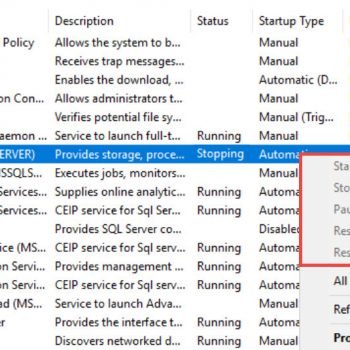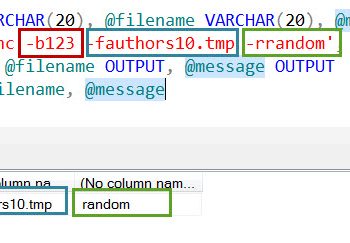I was recently delivering session on Performance Tuning subject. I was asking if there is any harm having duplicate indexes. Of course, duplicate indexes are nothing but overhead on the database system. Database system has to maintain two sets of indexes when it has to do update, delete, insert on the table which has duplicate indexes. There is also a possibility that indexes are overlapped.
For example,
Index1 have Col1, Col2, Col3 but Index2 have Col1,Col2,Col3,Col4,Col5. Here Index1 and Index2 are overlapping and there is no need of Index1, which should be removed.
Following is the script which does the same task. You can run the script, get duplicate indexes and overlapping indexes. Carefully review each of them first and test this by deploying on your development server (not on production). If this script has any issue, do write back and I will do necessary modifications.
;WITH MyDuplicate AS (SELECT
Sch.[name] AS SchemaName,
Obj.[name] AS TableName,
Idx.[name] AS IndexName,
INDEX_COL(Sch.[name] + '.' + Obj.[name], Idx.index_id, 1) AS Col1,
INDEX_COL(Sch.[name] + '.' + Obj.[name], Idx.index_id, 2) AS Col2,
INDEX_COL(Sch.[name] + '.' + Obj.[name], Idx.index_id, 3) AS Col3,
INDEX_COL(Sch.[name] + '.' + Obj.[name], Idx.index_id, 4) AS Col4,
INDEX_COL(Sch.[name] + '.' + Obj.[name], Idx.index_id, 5) AS Col5,
INDEX_COL(Sch.[name] + '.' + Obj.[name], Idx.index_id, 6) AS Col6,
INDEX_COL(Sch.[name] + '.' + Obj.[name], Idx.index_id, 7) AS Col7,
INDEX_COL(Sch.[name] + '.' + Obj.[name], Idx.index_id, 8) AS Col8,
INDEX_COL(Sch.[name] + '.' + Obj.[name], Idx.index_id, 9) AS Col9,
INDEX_COL(Sch.[name] + '.' + Obj.[name], Idx.index_id, 10) AS Col10,
INDEX_COL(Sch.[name] + '.' + Obj.[name], Idx.index_id, 11) AS Col11,
INDEX_COL(Sch.[name] + '.' + Obj.[name], Idx.index_id, 12) AS Col12,
INDEX_COL(Sch.[name] + '.' + Obj.[name], Idx.index_id, 13) AS Col13,
INDEX_COL(Sch.[name] + '.' + Obj.[name], Idx.index_id, 14) AS Col14,
INDEX_COL(Sch.[name] + '.' + Obj.[name], Idx.index_id, 15) AS Col15,
INDEX_COL(Sch.[name] + '.' + Obj.[name], Idx.index_id, 16) AS Col16
FROM sys.indexes Idx
INNER JOIN sys.objects Obj ON Idx.[object_id] = Obj.[object_id]
INNER JOIN sys.schemas Sch ON Sch.[schema_id] = Obj.[schema_id]
WHERE index_id > 0)
SELECT MD1.SchemaName, MD1.TableName, MD1.IndexName,
MD2.IndexName AS OverLappingIndex,
MD1.Col1, MD1.Col2, MD1.Col3, MD1.Col4,
MD1.Col5, MD1.Col6, MD1.Col7, MD1.Col8,
MD1.Col9, MD1.Col10, MD1.Col11, MD1.Col12,
MD1.Col13, MD1.Col14, MD1.Col15, MD1.Col16
FROM MyDuplicate MD1
INNER JOIN MyDuplicate MD2 ON MD1.tablename = MD2.tablename
AND MD1.indexname <> MD2.indexname
AND MD1.Col1 = MD2.Col1
AND (MD1.Col2 IS NULL OR MD2.Col2 IS NULL OR MD1.Col2 = MD2.Col2)
AND (MD1.Col3 IS NULL OR MD2.Col3 IS NULL OR MD1.Col3 = MD2.Col3)
AND (MD1.Col4 IS NULL OR MD2.Col4 IS NULL OR MD1.Col4 = MD2.Col4)
AND (MD1.Col5 IS NULL OR MD2.Col5 IS NULL OR MD1.Col5 = MD2.Col5)
AND (MD1.Col6 IS NULL OR MD2.Col6 IS NULL OR MD1.Col6 = MD2.Col6)
AND (MD1.Col7 IS NULL OR MD2.Col7 IS NULL OR MD1.Col7 = MD2.Col7)
AND (MD1.Col8 IS NULL OR MD2.Col8 IS NULL OR MD1.Col8 = MD2.Col8)
AND (MD1.Col9 IS NULL OR MD2.Col9 IS NULL OR MD1.Col9 = MD2.Col9)
AND (MD1.Col10 IS NULL OR MD2.Col10 IS NULL OR MD1.Col10 = MD2.Col10)
AND (MD1.Col11 IS NULL OR MD2.Col11 IS NULL OR MD1.Col11 = MD2.Col11)
AND (MD1.Col12 IS NULL OR MD2.Col12 IS NULL OR MD1.Col12 = MD2.Col12)
AND (MD1.Col13 IS NULL OR MD2.Col13 IS NULL OR MD1.Col13 = MD2.Col13)
AND (MD1.Col14 IS NULL OR MD2.Col14 IS NULL OR MD1.Col14 = MD2.Col14)
AND (MD1.Col15 IS NULL OR MD2.Col15 IS NULL OR MD1.Col15 = MD2.Col15)
AND (MD1.Col16 IS NULL OR MD2.Col16 IS NULL OR MD1.Col16 = MD2.Col16)
ORDER BY MD1.SchemaName,MD1.TableName,MD1.IndexName
Update: Additionally, please read the comment left by Paul Randal, why there is more modifications required to this query.
This is version one query. Please provide all your suggestions and based on the same, I will have final query posted on blog.
Reference: Pinal Dave (https://darkslategrey-bat-805937.hostingersite.com)





